The goal of marketing is to create a message that resonates with the customer. To connect with the consumer, a marketer must first understand the consumer. One way to do this is through social listening. In this post, I aim to highlight just a couple of features and drawbacks of some of the social listening platforms that I have used.
NetBase has various cool features such as geo-fencing, image recognition and audience insights. The geo-fencing feature allows the user to draw a polygon on any part of the map to view only social posts from that region. This can be very useful when analyzing data from a specific event, such as a concert. Image recognition is capable of reverse image searching, which scans images in posts to find things such as the company logo. This means that marketers can scan the internet to see where and how their logo is being used. Audience insights allows marketers to view what is of interest to their target audience. These features are however only available in premium accounts.
The one thing that I really disliked about NetBase was that the software is based on sampling. Netbase only takes 10% of the posts into account, thus keywords that do not generate a lot of posts will have a hard time using the software. Moreover, because it samples the data, marketers do not have access to all posts in case they want to do some manual social listening.
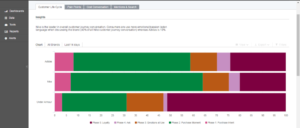 On the other hand, Brandwatch seems to be very simple to use. It has all of the basic functionalities that a company may need, including logo and competitor analyses similar to NetBase. Just like NetBase, Brandwatch gives the user the ability to create dashboards and export them at the end of the period. While Brandwatch does not have tutorials, it provides the user with various sample dashboards filtered by industry, which the user can copy and simply change the query and filters. Brandwatch also has pre-created categories which enable the user to drilldown into the data on various topics such as pain points and the customer lifecycle journey.
On the other hand, Brandwatch seems to be very simple to use. It has all of the basic functionalities that a company may need, including logo and competitor analyses similar to NetBase. Just like NetBase, Brandwatch gives the user the ability to create dashboards and export them at the end of the period. While Brandwatch does not have tutorials, it provides the user with various sample dashboards filtered by industry, which the user can copy and simply change the query and filters. Brandwatch also has pre-created categories which enable the user to drilldown into the data on various topics such as pain points and the customer lifecycle journey.
Brandwatch does however lack some functionality. One of the main functions that it lacks is quick search. If a marketer is exploring a new brand or customer target, they must do a full blown analysis, which will take more time than desired. Along the same lines, when a marketer creates a dashboard, it will only be filled with historical data from the previous month. If the user wants to fill the dashboard with more historical data, they will have to request a Backfill. Having to create your dashboard in advance can be very frustrating if you are trying to do exploratory research.
Additionally, while NetBase has a limitation on features, Brandwatch has a limitation on how much data can queried and on the number of queries per period. This again can be frustrating as doing exploratory research will count towards those quotas.
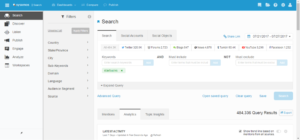 Sysomos has the best quick search feature out of all the platforms that I have used. It is very user friendly and has the most drilldown functionality. Unlike other platforms, in Sysomos, you can drilldown into a quick search to see a sentiment analysis and a topic insights chart. Moreover, a user can scroll through all of the posts the posts that matches their query, unlike on NetBase where you can only view a soundbite (i.e. 5 posts) as you drilldown into each metric.
Sysomos has the best quick search feature out of all the platforms that I have used. It is very user friendly and has the most drilldown functionality. Unlike other platforms, in Sysomos, you can drilldown into a quick search to see a sentiment analysis and a topic insights chart. Moreover, a user can scroll through all of the posts the posts that matches their query, unlike on NetBase where you can only view a soundbite (i.e. 5 posts) as you drilldown into each metric.
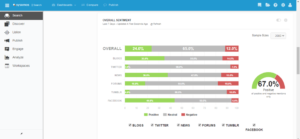 While there are dashboards and compare functions, Sysomos seems more like it’s a monitoring tool as opposed to a reporting tool. With Hootsuite-like features, a Sysomos user can schedule tweets to be posted at specific times or can look through a scroll of mentions and reply to those tweets. Therefore, while this platform may serve well as a basic social listening platform, it would not be very useful as a competitive analysis dashboard.
While there are dashboards and compare functions, Sysomos seems more like it’s a monitoring tool as opposed to a reporting tool. With Hootsuite-like features, a Sysomos user can schedule tweets to be posted at specific times or can look through a scroll of mentions and reply to those tweets. Therefore, while this platform may serve well as a basic social listening platform, it would not be very useful as a competitive analysis dashboard.
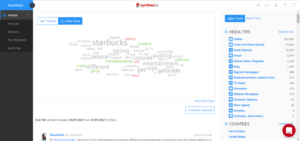 Similar to Sysomos, Synthesio has a very good quick search (called Flash Dash on the platform) that can look at historical data from up to a year prior. It also gives the user access to all of the posts if the user were to perform manual social listening. What Synthesio does better than Sysomos is providing the user with a list of the top influencers.
Similar to Sysomos, Synthesio has a very good quick search (called Flash Dash on the platform) that can look at historical data from up to a year prior. It also gives the user access to all of the posts if the user were to perform manual social listening. What Synthesio does better than Sysomos is providing the user with a list of the top influencers.
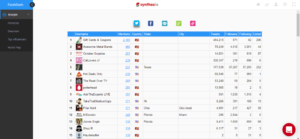 Users can save an unlimited amount of Flash Dashes, however they have a quota on the number of Dashboards a user can have at any time based on the subscription level. The dashboards provide a sentiment analysis and topic share analysis like the other platforms. However, there is no comparison tool and the built-in reporting is very basic.
Users can save an unlimited amount of Flash Dashes, however they have a quota on the number of Dashboards a user can have at any time based on the subscription level. The dashboards provide a sentiment analysis and topic share analysis like the other platforms. However, there is no comparison tool and the built-in reporting is very basic.
Any one of these platforms can be very useful in marketing decisions, the important thing is finding one that fits your objectives. Do you use any of these platforms? Can you think of other reasons why you might do social listening?